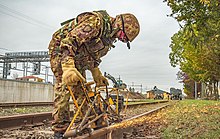Reggimento genio ferrovieri
The railway pioneer regiment ( Italian Reggimento genio ferrovieri ) of the Italian army was and is the only regiment of its kind within NATO . It is based in Bologna in Emilia-Romagna .
assignment
Railway pioneers belong to the pioneer group and are responsible for the repair and in some cases also for the operation or construction of militarily relevant railway lines . In Germany and many other countries, railway pioneer associations of this size were usually only set up in times of war. The Italian Railway Pioneer Regiment, which has very close relations with the Italian railways , is responsible for the maintenance of military railway lines and facilities as well as for the operation of mobile military railway facilities. In the event of disasters and on missions abroad, it restores damaged civilian railway lines. It supports the Italian railway regularly, whereby these services also serve the own training and further education.
organization
Since 2017, the Italian railway pioneer regiment has only consisted of a mixed construction and operating battalion (previously a construction and an operating battalion). It is located in Castel Maggiore near Bologna , one of the most important railway hubs in Italy . Militarily, the regiment is subordinate to the pioneering command in Rome, national support missions carried out under the direction of the Logistics Command of the Army. In addition to the standard light equipment and armament, it has heavy transport and special vehicles as well as its own train .
history
The Italian railway pioneers trace their history back to a Piedmontese sapper unit who, with the support of other units, built a 12 km long railway line from the port town of Balaklava to Kamara for replenishment purposes during the Crimean War in 1855 . During the Second Italian War of Independence , the railway pioneers played an important role, as troop movements were mainly carried out by rail. In 1859 they repaired the Casteggio - Alessandria - Casale - Vercelli railway line and ensured military operations.
Until 1873, the two pioneer regiments that existed at the time were jointly responsible for tasks of this kind. For this purpose, smaller sub-units of these regiments were appropriately trained, equipped and kept ready. In 1873 and 1877, the two pioneer regiments each set up two pure railway pioneer companies, for which detailed service regulations were issued in 1880 . In 1884 the four companies of the new 4th Pioneer Regiment were formed to form a railway pioneer battalion based in Turin , which in 1895 became independent within the pioneer group. It consisted of four construction and two operating companies.
In October 1910 the Railway Engineer Regiment (6th) was set up in Turin . It led a battalion in Turin (4 companies ), a battalion in Rome (2 companies), as well as a motor vehicle unit in Turin (which later became today's logistics group ) and a separate unit for the operation of the Turin - Pinerolo railway line . In 1911, the regiment was deployed in Libya during the Italo-Turkish War , where it operated the Tripoli - Ain Zara railway and set up three motorized units.
During the First World War , the 25 companies of the regiment built standard gauge lines with a total length of 147 km and 600 km of narrow-gauge lines as well as 144 iron bridges. The regiment repaired 2,774 km of railway lines, ensured military rail operations in the rear front area and brought 965 headlights into position at the front .
Between the two world wars, it was used with its two battalions to repair the Italian railway network and operated the Chivasso - Aosta and Bozen - Merano - Mals railway lines ( Bozen - Meran railway , Vinschgau railway ). Two construction companies and one operating company were sent for the campaign in Italian East Africa .
During the Second World War , the regiment comprised 13 construction battalions and three large operational battalions, which were deployed in various theaters of war and in different countries, where they built or repaired numerous railway bridges and operated and defended militarily important railway lines. The regiment received a high distinction for a combat mission in the Soviet Union , in which the 10th Battalion withstood massive Soviet attacks on the Don until December 19, 1942 (and then withdrew according to orders to avoid being surrounded).
From September 1943 to the end of the war, and especially in the post-war period, the units of the regiment, which had since been disbanded, repaired numerous war damage. During this time in particular, the close cooperation with the Italian railway developed, which continues to this day.
On October 1, 1957, the Railway Engineer Regiment was re-established, also in recognition of the post-war reconstruction work carried out by the various companies (united in a battalion since 1947). The regiment in turn consisted of a construction battalion based in Castel Maggiore near Bologna and an operating battalion in Turin. In later years the regiment also built numerous railway bridges on behalf of the Italian railway and in some cases received high awards because of the difficulty of the work.
Recently, the Italian railway pioneer regiment has also been used in peace missions abroad, particularly in the former Yugoslavia . In Bosnia and Herzegovina , it reactivated the 300 km long Novi Grad - Otoka - Martin Brod - Strmica railway from 1996 to 1998 and handed it over to the local railway. Parts of the regiment were then also active in Kosovo and Albania , as well as in Pakistan (2005–2006) and Eritrea .
In 2017, the construction battalion in Castel Maggiore and the operations battalion in Ozzano dell'Emilia were merged into a mixed battalion and the regiment was thus reduced to battalion strength.

